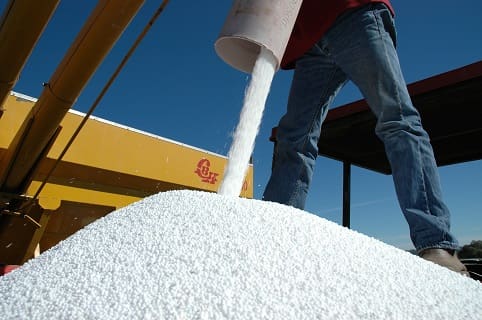
Spreading Urea
A WHITE paper has been presented to the Federal Government which aims to guide policy away from curbing the use of nitrogen in agriculture in order for Australia to meet its targeted reduction in greenhouse gas emissions.
Entitled Nitrogen Fertiliser Use and Greenhouse Gases – An Australian Assessment, the paper was written by Dr Robert Norton from Norton Agronomic and The University of Melbourne, the University of Queensland’s Dr Cameron Gourley, and Professor Peter Grace from the Queensland University of Technology.
Recommendations from the paper were developed in collaboration with Fertilizer Australia’s program manager Jeff Kraak, with input from its members.
The paper has been designed to provide information for governments and other policy makers about the current situation with emissions from nitrogen fertilisers in Australia.
Inhibitor subsidy recommended
One of the paper’s recommendations is that nitrification inhibitors be widely used to improve nitrogen-use efficiency and reduce nitrous oxide emissions.
It refers to a proposal written by Professor Grace and University of Melbourne Professor Richard Eckard in collaboration with Fertilizer Australia to subsidise farmer use of nitrification inhibitors.
Entitled Concept proposal for a pre-farm treated fertiliser aggregation payment, it looks at making urea coated with a nitrification inhibitor the same price to farmers as conventional urea, instead of around 14 percent more expensive per unit of N as it is at present.
“While highly effective at reducing N2O emissions from N fertiliser application, the actual N saved is typically less than 10kg/N per hectare per year,” the proposal states.
“In many situations, this saving is not agronomically significant for farmers and, not surprisingly, most of the research suggests no significant productivity benefit.
“If an offset method were developed to incentivise farmers to purchase this pre-coated fertiliser, the returns at an average grain farm would be less than $200 per farm per year; therefore, farmer adoption would be almost impossible to achieve.”
The proposal points to a public good from the Federal Government addressing this market failure by engaging in a pre-farm aggregation of N2O abatement with a limited number of fertiliser manufacturers, who would pre-coat fertiliser products at an agreed price per tonne.
“This payment would then be passed on to growers as a reduced price for treated N fertiliser.
“Therefore, adoption by the farming community would be increased significantly, as the product would be sold at a similar unit cost as standard urea.”
“We recommend that the Minister for Climate Change and Energy work with Fertilizer Australia and its members to develop this pre-farm treated fertiliser aggregation payment that will reduce emissions from N fertiliser use on Australian farms,” the proposal states.
Other recommendations from the white paper call for:
- Formal assessment of the effectiveness and risks of N inhibitors and slow-release technologies;
- Encouragement of greater adoption of objective tools like soil and plant testing, in line with Fertcare stewardship principles, to guide fertiliser use;
- Encouragement of greater adoption of precision agriculture tools that assist in spatially and temporally targetting inputs where and when they are most needed;
- Incentives for Australian manufacturers to produce N fertilisers with a low-carbon footprint;
- Engagement of industry bodies, research organisations and state and federal governments in sharing of data on inputs, NUE and N2O emissions.
- Avoidance of free-market disruption with taxes, levies or quotas on N fertilisers.
The white paper states 30pc of Scope 1 N2O emissions from agriculture are derived from fertilisers, with decomposition of crop residues and organic materials accounting for a further 30pc.
Direct deposition of dung and urine on 35pc, and locations where animal manure is stored and land applied at 5pc account for the other 40pc.
Fertilizer Australia executive manager Stephen Annells said the group was keen to provide some recommendations to government as it considered ways to achieve its emission reduction targets.
“The fertiliser industry wants to work with the federal government to avoid decisions such as the 30pc nitrogen fertiliser deduction in Canada…that may not have the desired effect on emissions but may cause significant damage to Australia’s agriculture, regions and prosperity from exports,” Mr Annells said.
The Albanese Labor Government has committed to reduce greenhouse gas emissions to 43pc below 2005 levels by 2030.
A significant source of emissions from agriculture comes from the use of nitrogen fertilisers.

HAVE YOUR SAY